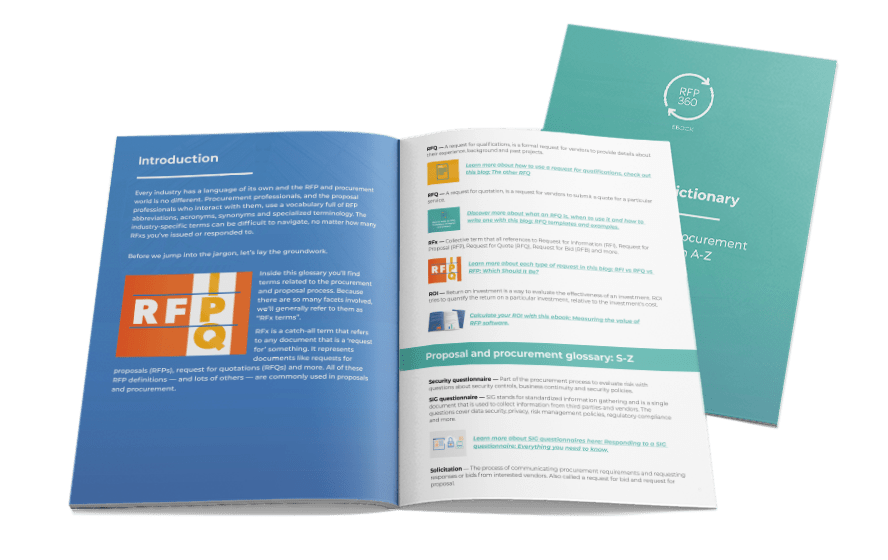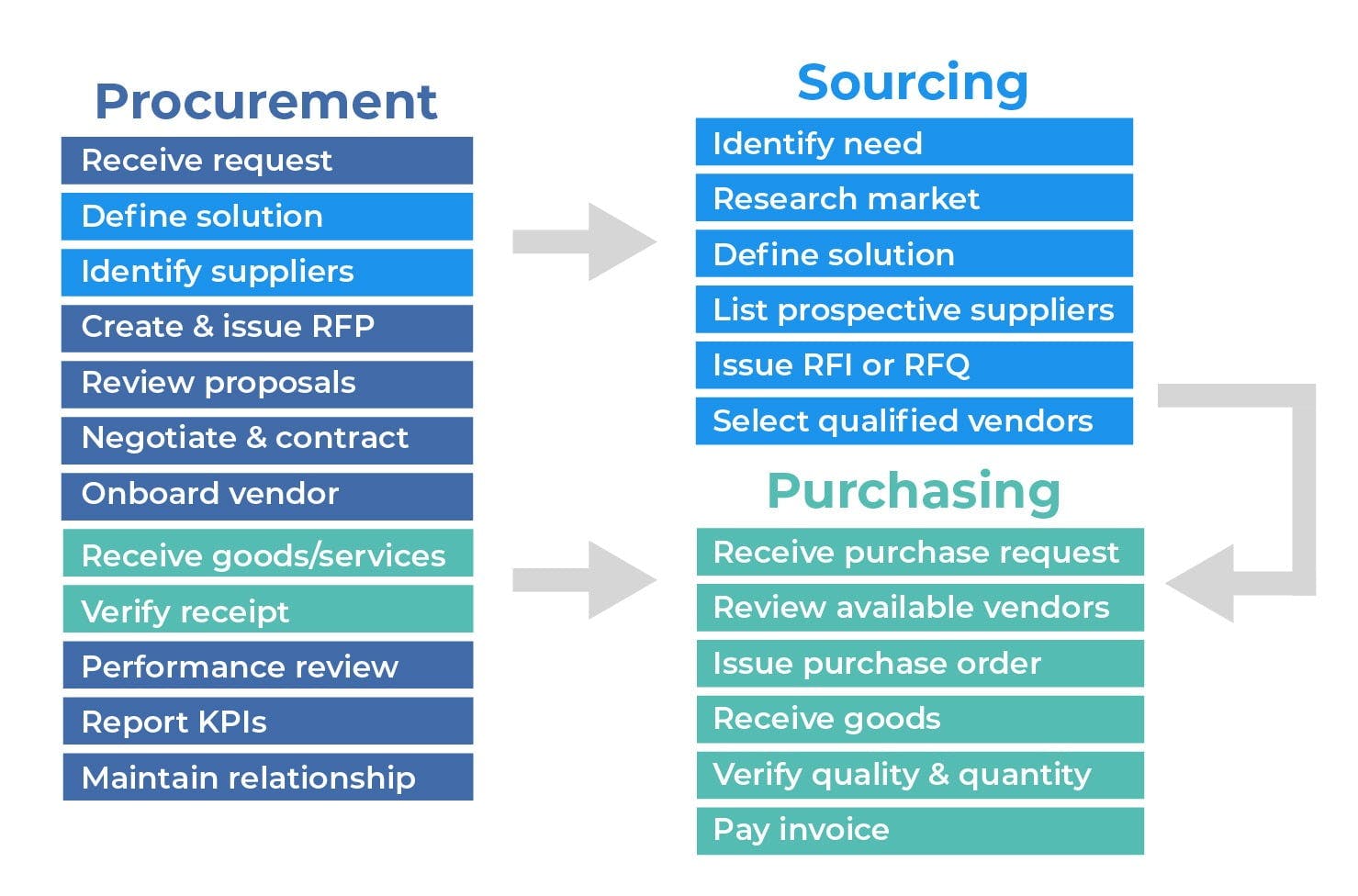When you’re buying for your business, what do you call it? It seems like an easy question, but there are a lot of terms that refer to this process. On the surface, they all seem to mean the same thing. Some call it procurement. Others say purchasing. And, still others call it sourcing. Knowing which term means what is confusing and, admittedly, nuanced. So, what is the difference between procurement vs. purchasing vs. sourcing?
In this blog we’ll share everything you need to know to sound like a pro when talking about buying for your business. First, we’ll share the individual definitions of procurement, purchasing and sourcing. Then, we’ll explore the differences between all three. Finally, we’ll offer example scenarios to explain procurement vs purchasing vs sourcing.
- Definitions of procurement, purchasing and sourcing
- Differences between procurement vs. purchasing vs. sourcing
- Comparison table: Procurement vs. purchasing vs. sourcing with examples
Definitions of procurement, purchasing and sourcing
To understand the differences between procurement vs purchasing vs sourcing, we must start with their definitions. Often, these terms are used interchangeably and how your organization uses them might be slightly different. But, for the purposes of this article, we’ll use these definitions.
What is procurement?
Procurement is both a process and a profession. Procurement as a process is the management of high-value or strategic purchases. This is done by researching a need, finding a solution, comparing vendors and selecting the best fit while also maximizing value and minimizing risk. Typically, the procurement cycle starts with a stakeholder request and uses a request for proposal (RFP) or other competitive bidding process to make a data-based decision. This process can be partially automated with RFP software and depends on qualitative analysis and data-based decision making.
In addition, you may have a procurement department or team within your organization. The most common role is the procurement manager, though there are several different procurement career paths. Often, this group of practitioners is collectively referred to as ‘procurement’. While they do manage the procurement process, they are also responsible for spend, contract, vendor and category management.
What is purchasing?
Purchasing is the process of facilitating transactions between your business and a seller. Generally, purchasing refers to tactical, transactional buying of goods and services. The purchasing cycle includes creating a purchase order (PO), receiving delivery and processing payment. Your organization may use an enterprise resource planning (ERP) solution to facilitate the purchasing process.
What is sourcing?
Sourcing is the process of identifying suppliers who can provide the materials, goods and services you require. The term sourcing is commonly used when discussing direct spend in manufacturing. Sourcing identifies several possible vendors that can provide a material. Then, the process tracks and identifies the best source to purchase from at any given time.
For more definitions of procurement terms, acronyms and jargon, check out the RFP glossary.

How procurement, purchasing and sourcing are related
All three business buying terms refer to processes that are managed within the procurement department. Procurement, as a practice, encompasses a wide range of activities that includes both purchasing and sourcing.
Specifically, sourcing finds, vets and qualifies vendors for future purchases. This activity can be related to or entirely separate from a current procurement or purchasing project.
The purchasing process happens with vendors who have already been through onboarding or for smaller purchases that don’t require an RFP. Your procurement policy provides guidance on which projects require the full procurement process vs which can be managed with the purchasing process.
Procurement vs purchasing vs sourcing processes
The processes involved with procurement, purchasing and sourcing all relate to one another. Here you’ll see the process for a procurement project and how it relates to purchasing and sourcing.

Differences between procurement vs. purchasing vs. sourcing
Because sourcing is related to, but independent from procurement and purchasing, we’ll set it aside for now and focus on procurement vs purchasing.
Procurement vs purchasing
Project value: High cost vs. low cost
One of the biggest differences between procurement and purchasing projects is the value. As mentioned above, if the proposed cost of the goods or services exceeds a threshold set by the procurement policy, an RFP is required, which makes it a procurement project. Alternatively, purchases below that amount follow the purchasing process instead.
Project impact: Strategic vs. tactical
Another difference between procurement and purchasing is impact and scope. Procurement projects are high impact, meaning the outcome of the purchase could have far-reaching consequences for the organization. In procurement projects, making the wrong choice could impact revenue, operations or reputation.
On the other hand, purchasing projects tend to be tactical and transactional. Indeed, they may be planned or unplanned, but their impact is isolated to a small part of the business. So, even if the purchase goes poorly, the consequences are minor and can be mitigated without undue stress on the organization.
Project goal: Maximize value vs fast solution
Will you work with the vendor long term or just one time? Due to the complexity and investment required to conduct a procurement project, the process is better suited to establishing long-term relationships. Ongoing vendor relationships can deliver additional value like offering custom solutions, sharing market insights and solving challenges collaboratively.
Conversely, purchasing projects focus on meeting an immediate need. Because the purchase may be ad hoc, a one-time solution or a routine purchase, investing time in building a relationship isn’t necessary. Indeed, the interaction is fast and straightforward — an order is submitted, fulfilled and paid for with little negotiation or collaboration required.
Procurement and purchasing vs sourcing
Often, procurement and purchasing are frequently used interchangeably. And, they both describe the process of buying a good or service on behalf of your organization. Sourcing, however, is different because a purchase is not implied or required. Essentially, sourcing is the process of finding prospective vendors and suppliers that would be good options for your organization. From there, you may create vendor profiles to organize their information. Then, when a procurement or purchasing project arises, you can save time selecting the right vendor(s) for your needs.
Table: Procurement vs. purchasing vs. sourcing with examples
PROCUREMENT
Cost
High value
Impact
Strategic
Goal
Maximize value
Relationship
Ongoing
Managed by
Procurement manager
Example
Your organization needs to find new employee benefits. This is a costly project that impacts the entire organization. Ideally, you plan to work with a provider for at least two to three years. The project is initiated by the human resources team and managed by procurement. An RFP gathers vendor information and details the project background, scope and goals. Finally, you receive proposals and select a vendor.
PURCHASING
Cost
Low value
Impact
Tactical
Goal
Speed
Relationship
Transactional
Managed by
Buyer
Example
The marketing department needs to buy a sound system for an upcoming event. Within your catalog, you identify an audio/visual vendor that has been sourced previously. Because the purchase is well below the cost threshold stated in the procurement policy, an RFP isn’t necessary. A purchase order is created, sent and received by the vendor. Then, the order is filled, delivered and verified.
SOURCING
Cost
High and low value
Impact
Tactical and strategic
Goal
Vet vendors
Relationship
Ongoing and transactional
Managed by
Sourcing manager
Example
Your organization will be manufacturing a product that requires a steel component. First, the procurement team must find prospective vendors able to provide the component. So, you research vendors, issue a request for quotation (RFQ) or request for information (RFI) and identify three vendors that meet your deliver, quality and cost needs. You add these vendors to your catalog for future purchases.
To summarize, the procurement process is a good fit for expensive, strategic, long-term projects because it is more detailed than the purchasing process. Accordingly, it takes longer and is more complex, but does a better job of controlling cost and exposing potential risk. On the other hand, the purchasing process is fast and delivers results quickly. It’s a good fit for projects with minimal spend and risk. And finally, sourcing is the process of researching, identifying and vetting prospective vendors for future procurement and purchasing projects.
Ultimately, people will use these three terms in a variety of ways, but with this context you’ll now be able to confidently contribute to the conversation.

